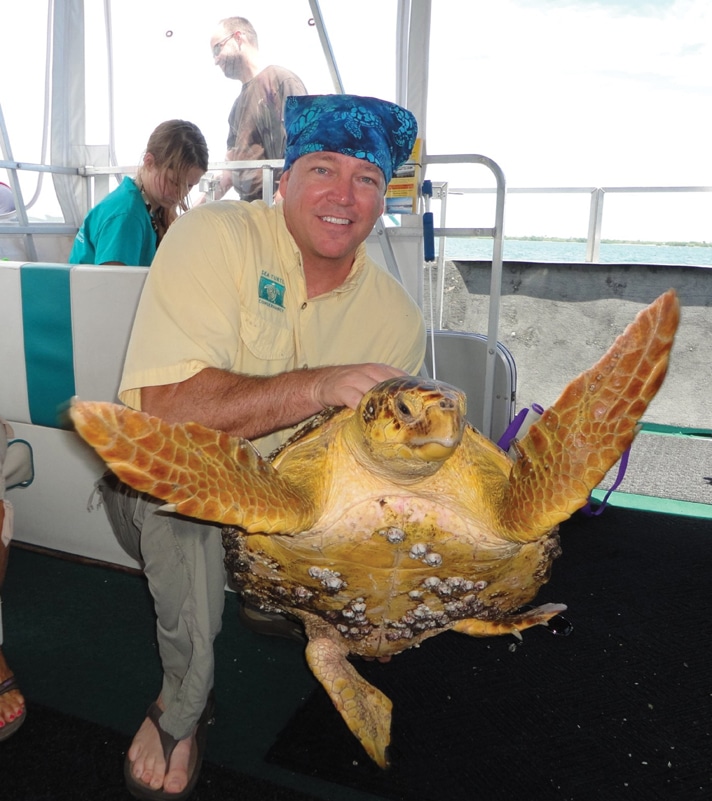As wild herps face unprecedented challenges, conservation groups work together to restore species and habitat.
The inspiration that leads someone to conservation is often very personal. For me, it was the moment I learned about the concept of keystone species, how it related to frogs and toads, and that they are critically endangered.
Every conservationist has deeply personal reasons for caring so much, but when it comes to making a difference, especially in wild herp survival and habitat conservation, our greatest strength is in cooperation. That’s why REPTILES decided to reach out to help tell the stories of some of the organizations having the largest impact in herp conservation, in the hope that they will inspire you and raise awareness of some of the world’s most pressing environmental issues.
Turtle Survival Alliance (TSA)
History: The Turtle Survival Alliance came into being in 2001 specifically in response to the Asian Turtle Crisis, where unsustainable harvest of Asian turtle populations was leading to serious concerns for a number of species. In 2005 the TSA registered as a non-profit, but by 2008, it switched to a more corporate structure with a formal board of directors, and in 2013, it opened the Turtle Survival Center (TSC) in Cross, South Carolina, effectively establishing its base of operations there.

Courtesy Christina Castellano
Turtle Survival Alliance President and CEO Rick Hudson holds a radiated tortoise (Astrochelys radiata) at the TSA’s facility in Antananarivo, Madagascar.
“We are an umbrella organization that brings expertise from all of those groups together to bear on turtle conservation,” said Rick Hudson, president of the TSA. “We have 900 dues-paying members. We have a lot of institutional support from zoos and conservation organizations.”
Operational outline: The TSA’s mission is to involve as many people in turtle and tortoise conservation as possible. “We are committed to zero turtle extinctions for the 21st century,” Hudson said. “Our mantra has been, ‘Transforming passion for turtles into conservation action.’”
This ethos has led the TSA to promote various methods to support turtles and tortoises, in addition to its captive-breeding efforts. “Turtle conservation is so much bigger than just one group,” Hudson said. “It can’t just be captive breeders. It can’t just be academics. It can’t just be zoos.”
Species focus: The TSA has focused extensively on Asian box turtles of the genus Cuora, and is supporting 12 of the 13 species in the genus through captive breeding.
There are other successes, as well, according to Hudson. “We’ve taken some species that have been on the brink of extinction, such as the Burmese star tortoise [Geochelone platynota] and the Burmese roof turtle [Batagur trivittata] that were just about to blink out,” Hudson said. “They were functionally extinct in the wild, and we’ve taken those through the recovery process, where now we’ve built up large numbers in captivity.”
The TSA released 1,200 star tortoises in February 2018, building on successful trial releases over the past couple of years. Its efforts with multiple turtle and tortoise species are ongoing.
Goals and accomplishments: One of the greatest TSA successes Hudson points to is the establishment of the Turtle Survival Center in South Carolina, where captive-breeding efforts are underway. The TSA also supports local outreach, education, habitat preservation and other conservation efforts.
“Our commitment to zero turtle extinctions isn’t just a slogan,” Hudson said. “It’s something we’ve really put into practice. This is a battle that we can win. Conservation’s always two steps forward and one step back. We have to celebrate these victories when we get them. But I’m seeing hope.”
Partners in Reptile and Amphibian Conservation (PARC)
History: One of the most effective means of implementing herp conservation is to help people work together, which became clear while speaking with JJ Apodaca, senior co-chair of PARC.
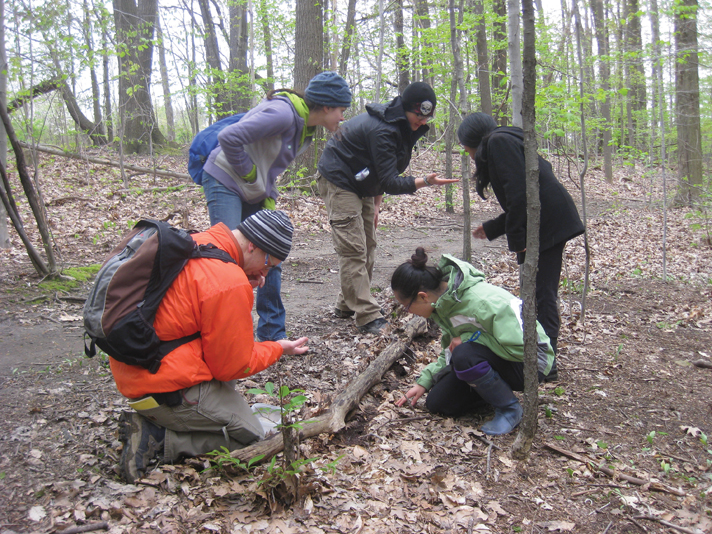
courtesy mike benard
Members of Midwest Partners in Reptile and Amphibian Conservation (PARC) explore some woodsy habitat while searching for reptiles and amphibians.
“I like to think of it as an organized network of people who are interested in the conservation of amphibians and reptiles,” Apodaca said. “We tend to bring together a wide variety of interested parties, from academia, to NGOs and government, to hobbyists and everybody else.”
PARC was founded in 1999 when herpetologists and people associated with certain governmental agencies saw that there was a need for such an organization. They loosely based the concept for PARC on some of the bird conservation organizations — specifically, Partners in Flight — whose accomplishments with avian preservation they wished to emulate.
According to Apodaca, the National PARC serves as a kind of steering committee for the direction of the organization and establishes management guidelines. PARC is further organized into five regional working groups that serve as the operating arms of the organization, and in addition, there are several other subchapters and regional PARC organizations, all driven by volunteers.
Operational outline: The people at PARC have tried to make the organization the spark that builds the momentum for conservation to be accomplished, Apodaca stated. “We have a new strategic plan that lays out how we see ourselves functioning. The basics are broken down into three main components: networking, species and habitat. For the next five years, that’s where we’re really going to be focusing our energy.”
Networking is foundational, and PARC’s focus on species involves taking inventory, creating documentation and setting population monitoring guidelines. Going forward, the idea is to create more products that facilitate management programs. PARC also seeks to preserve and enhance herp habitat.
Species focus: While PARC’s mission obviously necessitates paying attention to a wide variety of threatened species, there are a few notable herps on its radar. For one, the organization is preparing and will soon release its conservation action plan for the timber rattlesnake (Crotalus horridus). Between persecution and snake fungal disease, Apodaca stated, rattlesnakes are of major concern. Western pond turtles (Actinemys marmorata) and bog turtles (Glyptemys muhlenbergii) are also high on PARC’s priority list.
Goals and accomplishments: “We’ve been very effective at bringing light to the importance of conservation of amphibians and reptiles, especially to state and federal agencies,” Apodaca said. “Over the 19 years PARC has been around, that’s probably the most successful thing PARC has done.”
Between facilitating research and publishing materials that assist herp conservation, PARC has helped focus efforts and identify best practices. Its habitat management guidelines and its inventory and monitoring guidelines all serve to make a large amount of knowledge readily accessible.
By bringing together so many groups and so much talent, PARC plans to expand its reach and further impact herp conservation efforts.
“We’re aiming to continue to grow that network,” Apodaca said. “Hobbyists and the general public who have an interest in amphibians and reptiles are an incredibly important part of that network that we haven’t totally tapped into and fully brought into the fold.”
Amphibian and Reptile Conservancy (ARC)
History: Partners in Reptile and Amphibian Conservation and the Amphibian and Reptile Conservancy go hand-in-hand, according to ARC executive director Jeff Holmes. ARC facilitates collaborative partnerships nationwide in herp conservation, he said, and serves as the non-profit fiscal sponsor of PARC.
“PARC is all of the government agencies, universities, zoos, aquariums, pet trade industry, timber companies — anybody who has an interest in herp conservation is involved,” Holmes said. “We handle all of their money, we underwrite all of their projects, and we put experts together with projects, sort of like what the American Bird Conservancy does for Partners in Flight.”
Operational outline: ARC also provides daily educational messaging on social media and tries to push forward a pro-herp conservation agenda to reach people’s hearts and minds. The organization also conducts professional training on a wide variety of topics, Holmes noted, including habitat management, species recognition and other conservation activities. Part of ARC’s plan is to use these training sessions as a means of public outreach, and when possible, partners are asked to open these sessions to the public.
ARC also does a lot of grant contract and especially cost-sharing work with large land owners, especially the federal and state governments.
Species focus: Given its broad mission, ARC focuses on a wide variety of amphibians and reptiles, and oversees restoration of wetlands for California red-legged frogs (Rana draytonii), copperbelly water snakes (Nerodia erythrogaster neglecta), Chiricahua leopard frogs (Lithobates chiricahuensis), and blue-spotted (Ambystoma laterale) and Jefferson (A. jeffersonianum) salamanders, among many other species.
“We also have some outstanding rare species projects,” Holmes added. “We just wrapped up with Dr. Gary Casper on a wood turtle [Glyptemys insculpta] project near the Canadian border. We think we found the best population on Earth.”
Goals and accomplishments: Wetlands restoration has produced some of the largest payoffs, Holmes noted. An added benefit is that as volunteers are working on wetlands restoration, ARC is training them in the process. As of this writing, ARC has restored more than 50 wetland habitats, from New England to the West Coast.
“Every single one was for rare species, and every single one doubled as a training workshop,” Holmes said. “That’s where we get $100 worth of conservation out of $10 worth of conservation funding. That really helps us make an impact.”
In addition, ARC runs online training sessions, has four or five rare species studies ongoing right now, and is working closely with partners on several projects. ARC also underwrites the Habitat Management Guide Series for PARC.
Despite ARC’s wide-ranging activities, Holmes still loves to get his feet wet. “I’m a fielding herper trapped in an administrator’s body,” he said. “I get out there every chance I get. That’s how I came into this. You become a field herper, and somebody paves over your favorite spot, and you’ll say, ‘We’ve got to do something about this conservation business.’”
Amphibian Ark (AArk)
History: “The Amphibian Ark is very much an umbrella organization,” stated Kevin Johnson, taxon officer and communications and development officer for the group. “In 2005, the IUCN SSC Amphibian Specialist Group (ASG) tasked the IUCN SSC Conservation Breeding Specialist Group — CBSG, now known as the Conservation Planning Specialist Group, CPSG — with managing and implementing the ex situ components of the Amphibian Conservation Action Plan.”
The Amphibian Ark was subsequently established in 2006 as a joint effort of three primary partners — CBSG, the World Association of Zoos and Aquariums (WAZA) and the ASG — to create a global network of captive-breeding programs explicitly linked to conservation and research programs.
Operational outline: “Our vision is of the world’s amphibians thriving in nature,” Johnson said. “Our mission is ensuring the survival and diversity of amphibian species, focusing on those that cannot currently be safeguarded in their natural environments.”
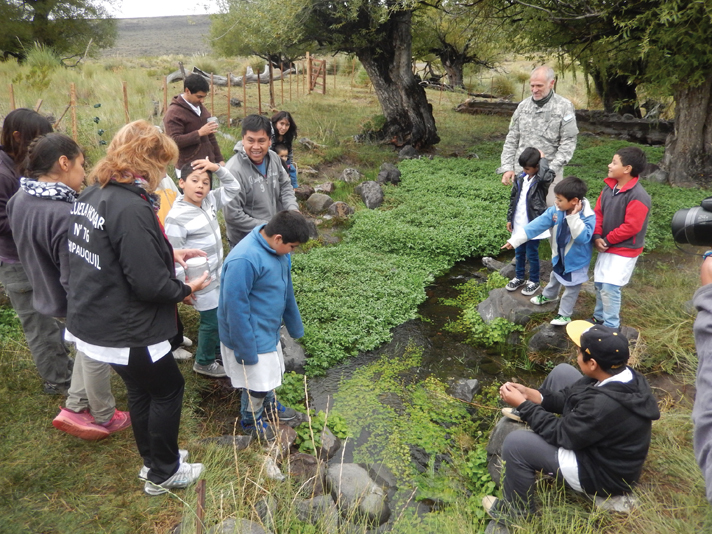
Courtesy Federico Kacoliris, Museum of La Plata, Argentina
Captive-bred Valcheta’s frogs (Pleurodema somuncurense) were released into restored and protected habitat on the Somuncura Plateau in Argentina by students, teachers, local residents and park rangers.
Ideally, species conservation should focus on supporting wild populations, according to Johnson. However, ex situ conservation, which is done outside the natural environment, is considered a necessity when it is highly unlikely threats in the wild can be mitigated before a species becomes extinct. To that end, AArk works to ensure that ex situ conservation programs are part of integrated plans, including mitigation of threats and habitat protection. Amphibian Ark manages the amphibian Conservation Needs Assessment (CNA) program, which selects and prioritizes species for ex situ conservation programs and also in situ actions.
Species focus: Johnson notes that it’s estimated there are more than 2,000 threatened amphibian species, and AArk’s goal is to evaluate all of them. Some high-priority ex situ conservation programs include those for the Titicaca water frog (Telmatobius coleus) in Peru, the Valcheta frog (Pleurodema somuncurense) in Argentina, the Montseny brook newt (Calotriton arnoldi) in Spain and the UK, Archey’s frog (Leiopelma archeyi) in New Zealand, the Kihansi spray toad (Nectophrynoides asperginis) in Tanzania and several U.S. zoos, and the Corroboree frog (Pseudophryne corroboree) in Australia.
Goals and accomplishments: “Our short-term goals are to assess all amphibian species for their conservation needs,” Johnson said. “Hand-in-hand with this, of course, is the need for sufficient resources to actually implement and manage those programs.”
Since 2009, AArk has provided more than $125,000 in seed grants to 26 programs in 16 countries. To date, AArk and its partners have also developed and delivered 64 training courses in 33 different countries.
“The Conservation Needs Assessment process has been used to generate almost 2,700 assessments for more than 2,300 species of amphibians, which is 30 percent of the 7,700 currently known species,” Johnson said. “In the long-term, our goal is to see threats in the wild mitigated, critical habitats repatriated and protected, and self-sustaining amphibian populations back in the wild.”
Save the Frogs!
History: Established in 2008 by founder Dr. Kerry Kriger, who serves as the executive director and ecologist for the organization, Save the Frogs! was created to ensure wild frog and toad populations can thrive in the wild, and the group seeks to raise awareness and get people thinking about amphibian conservation.
“There is no organization on the planet like us,” Kriger said. “We’re focused on educating people about amphibians and protecting their habitats. Our mission is to preserve amphibian populations and promote a society that respects and appreciates nature and wildlife.”

save the frogs
One of the most active Save the Frogs! chapters is the one in Ghana, West Africa, where the giant squeaker frog (Arthroleptis krokosua) is threatened.
Operational outline: Save the Frogs! is all about education, outreach and active engagement. It doesn’t implement breeding efforts, and according to Kriger, has no plans to go in that direction. Save the Frogs! focuses on active engagement, and outreach has become the organization’s biggest role.
To that end, Save the Frogs! Day was created to encourage frog lovers of all stripes to do something beneficial for amphibians in their own community — wherever they are, at whatever level they’re able to do.
“We’ve had about 1,300 Save the Frogs! Day events all over the world,” Kriger said. “That gets average people … doing something beneficial for frogs, rather than just sitting at home thinking about how much they love frogs or how much they hate that frogs are going extinct. That’s always been the No. 1 way that we’ve gotten people active, aside from our own activities.”
Species focus: One key aspect of Save the Frogs! activities is building wetlands. The group has probably been involved in around 30 wetlands projects, Kriger said, which it has either led or been part of, mostly in California and Arizona.
“One of our main species has been the California red-legged frog [Rana draytonii],” he stated. “We just built a wetland at a school in Los Angeles. Some of those wetlands are at schools so that we can get kids involved, getting them to help us build the wetland, so that they can get inspired and educated.” Another species of concern is the mountain yellow-legged frog (R. muscosa), also in California.
Outside of the U.S., the most active Save the Frogs! chapter is the one in Ghana, West Africa, where the giant squeaker frog (Arthroleptis krokosua) and togo slippery frog (Conraua derooi) are threatened.
Goals and accomplishments: According to Kriger, the main goal of Save the Frogs! is to raise awareness of the problems facing amphibian conservation, and on this front it has succeeded.
Success has also come in the form of legal advocacy. When San Francisco recently tried to build a fish weir in Little Yosemite Canyon on the Alameda Creek, Save the Frogs! stopped the project through legal action. “That tends to be the No. 1 way to get a politician to act,” Kriger said. “Otherwise, I unfortunately find that most politicians don’t act on behalf of frogs, though some of them do.”
Sea Turtle Conservancy (STC)
History: The Sea Turtle Conservancy was founded by Archie Carr in 1959, originally as the Caribbean Conservation Corporation. Carr was one of the foremost herpetologists and ecologists in the world at that time, according to STC executive director David Godfrey, and it was the first group anywhere in the world created to study and protect sea turtles, which have remained its focus.
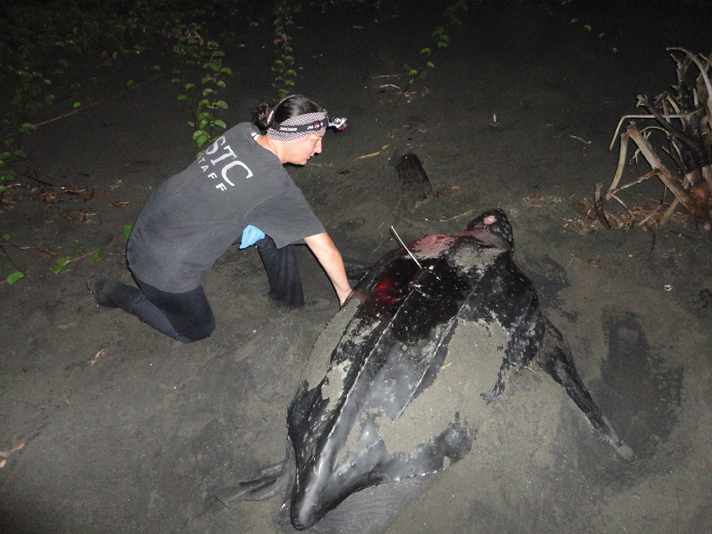
sea turtle conservancy
Satellite tracking is one of the many tools the Sea Turtle Conservancy uses to monitor the migration of species, including this leatherback.
The conservancy’s conservation efforts began with the sea turtle nesting beach of Tortuguero in Costa Rica, a site that remains one of the world’s most important nesting sites for the green sea turtle (Chelonia mydas).
Operational outline: The STC has expanded greatly since its early days, and now seeks to support all sea turtle species in the wild. “We’re, of course, no longer just based at Tortuguero,” Godfrey said. “We have research and conservation programs throughout the United States and the Caribbean.”
The STC engages in habitat support, conservation-focused research and policy work to help shape legislation, regulations and enforcement to protect sea turtles and their habitats. There’s also the ever-increasing problem of plastic pollution in the oceans, which impacts nearly all sea turtle species.
Species focus: While the green sea turtle has been a huge focus for the STC, other species receive support from the organization, as well. The hawksbill sea turtle (Eretmochelys imbricata) is increasingly threatened, and the STC’s work in Panama is focused on the species. Godfrey noted growing populations of leatherback sea turtles (Dermochelys coriacea) in Panama, and stable-to-growing populations of loggerhead sea turtles (Caretta caretta) across the southeastern U.S.
Goals and accomplishments: Archie Carr’s legacy lives on, but there’s more to do. The TSC started a movement, according to Godfrey, and we have seen many sea turtle populations begin to recover.
The establishment of Tortuguero National Park in Costa Rica, which the TSC helped create, is a crowning achievement for the organization. The TSC has also played a major role in international progress toward conservation, including implementing CITES regulations that ban the trade of sea turtles.
“I’ve worked for the organization for 25 years personally,” Godfrey said, “and I’ve seen a lot of incredible success. There’s positive news out there. Conservation can work. We’ve seen it, we’re achieving it. But big challenges remain.”
International Reptile Conservation Foundation, Inc.
History: The International Reptile Conservation Foundation (IRCF) was founded in 2001 for the purpose of pursuing herp conservation and supporting natural habitats and ecosystems, according to Chris Pellecchia, head of special projects for the IRCF. It is a support organization that is entirely volunteer-driven, and it assists and enhances conservation efforts being conducted by other organizations, agencies, institutions and individuals.
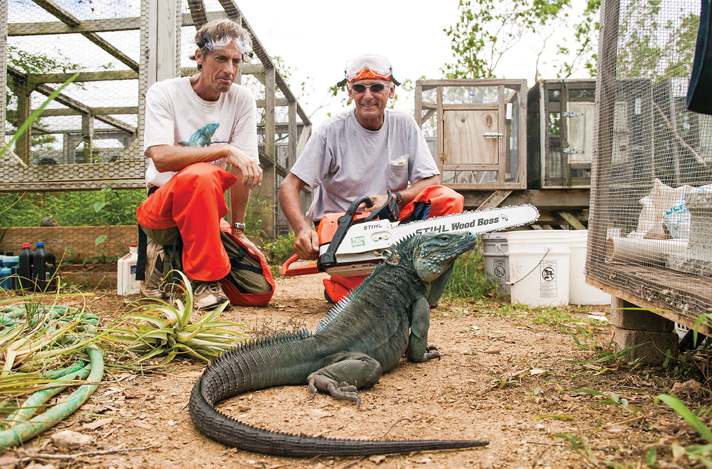
The International Reptile Conservation Foundation
Fred Burton (left), John F. Binns and “Slugger,” a Cyclura lewisi, during Hurricane Ivan clean-up efforts at the Grand Cayman Blue Iguana Recovery Program headstart facility.
“Our goal is to be a force-multiplier and to enhance projects in need,” Pellecchia said. “We work in concert with the scientific community, educators, corporate and individual sponsors, local governments, and other professional conservation organizations as a part of the complete conservation solution.”
Operational outline: The IRCF augments efforts by providing extra tools required by conservationists and researchers. The organization has partnered in a wide array of conservation programs, from in situ captive-breeding programs to community development strategies to prevent poaching. Its efforts include fundraising, land acquisition, logistical support, communications and promotion of species awareness, publications, and volunteer coordination when needed.
Species focus: The IRCF has had a hand in supporting conservation and head-start programs for species such as the Grand Cayman blue iguana (Cyclura lewisi) in the Cayman Islands and arboreal alligator lizards (Abronia sp.) in Guatamela.
Other IRCF-supported conservation efforts include programs for the Guatemalan beaded lizard (Heloderma horridum charlesbogerti), Lesser Antillean iguana (Iguana delicatissima), Argentine sand dune lizard (Liolaemus multimaculatus), Bahamian rock iguana (Cyclura cychlura), Chinese alligator (Alligator sinensis) and many others.
Goals and accomplishments: According to Pellecchia, the IRCF actively campaigns and fundraises for conservation efforts, and also publishes the group’s open-source, peer-reviewed, quarterly scientific journal, Reptiles & Amphibians: Conservation and Natural History. As mentioned, the IRCF also has a hand in land-acquisition and land-transfer services for conservation purposes.
Pellecchia considers one of the IRCF’s greatest achievements to be its partnering with and assisting the Blue Iguana Program on Grand Cayman Island. “The successful and iconic head-start program brought a truly magnificent species back from the brink,” he said. “It’s a good representation of how many volunteers and organizations partnered together for a conservation success story.”
Herp conservation is everyone’s responsibility, and hobbyists are well suited to get a movement started and build awareness on the topic of reptile and amphibian preservation in the wild. Any of the groups profiled in this article are worthy of your support, and if you’d like to engage directly in conservation activities, these organizations are wonderful places to start.
Ethan D. Mizer is a writer and journalist working in Southern California.

